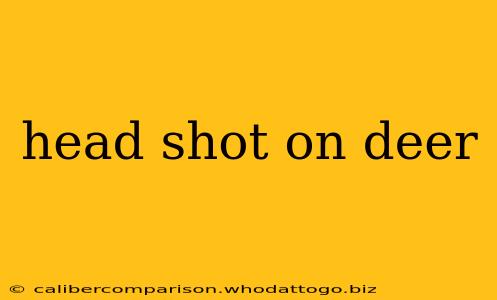Taking a head shot on a deer is a controversial topic among hunters, sparking debates about ethics, legality, and the effectiveness of the shot placement. This comprehensive guide delves into the nuances of this hunting technique, exploring its implications and providing insights for ethical and successful hunting.
Ethical Considerations of Head Shots on Deer
The ethical debate surrounding head shots centers on the humane treatment of animals. While a well-placed head shot can result in immediate death, a poorly executed shot can cause unnecessary suffering. The small target area and potential for a miss, resulting in a wounded animal, are major concerns. Many ethical hunters prioritize shots that ensure a quick and clean kill, minimizing the animal's pain and distress. A broadside or quartering-away shot, targeting the heart and lungs, is generally considered more ethical by many due to the larger target area and higher probability of a clean kill.
Key ethical considerations include:
- Accuracy: A head shot demands exceptional accuracy. Hunters must be confident in their shooting skills and the capabilities of their firearm at the expected range.
- Shot Placement: Even a slight miss can result in a wounded animal. The potential for a non-lethal or agonizing injury necessitates a high degree of precision.
- Animal Welfare: The primary focus should always be on minimizing the animal's suffering. A head shot, while potentially quick, carries a higher risk of failure compared to other shot placements.
Legality of Head Shots on Deer
The legality of head shots varies depending on location and specific hunting regulations. While some jurisdictions may explicitly prohibit head shots, others may allow them under specific conditions or with certain restrictions (like using specific calibers). It's crucial to consult the local hunting regulations and game laws applicable to the hunting area before taking any shot. Failure to comply with these regulations can result in significant penalties. Always check with your state's wildlife agency or conservation department for definitive information.
Best Practices for Responsible Hunting
Responsible hunting emphasizes ethical considerations and adherence to the law. Even if head shots are permitted, responsible hunters should prioritize shot placement that maximizes the chances of a clean kill and minimizes the potential for wounding an animal. Here are some best practices:
- Know Your Limits: Understand your shooting skills and the limitations of your firearm. Don't attempt a head shot if you lack the confidence or proficiency to ensure a clean kill.
- Proper Equipment: Use a firearm and ammunition appropriate for the distance and target. Ensure the equipment is well-maintained and properly sighted-in.
- Patience and Shot Selection: Wait for a clear shot that allows for precise placement. Don't rush the shot; a well-placed shot is far more important than a quick one.
- Shot Follow-up: If a shot is taken, be prepared to follow up appropriately. If there is any doubt about the effectiveness of the shot, ensure you take steps to recover the animal ethically and humanely.
Conclusion: Prioritizing Ethical and Legal Hunting
The decision of whether or not to take a head shot on a deer should be made carefully, considering both the ethical and legal implications. While a well-placed head shot can result in a quick and humane kill, the risks involved necessitate a high level of skill, precision, and adherence to responsible hunting practices. Always prioritize ethical considerations and ensure compliance with local regulations before making this choice. Remember, responsible hunting is about respecting the animals and upholding the integrity of the hunting tradition.

